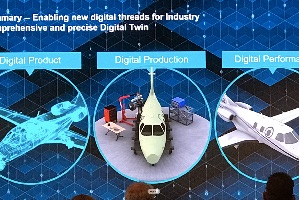 What is the Siemens Digital Twin strategy and how does it compare to others? This post shares our perspective on Siemens PLM’s vision to help manufacturers develop and derive value from virtual twins. The post expands on our more general post sharing our high level perspectives on Siemens PLM Strategy which includes links to other, more detailed analysis of the Siemens strategy for the Digital Innovation Platform.
What is the Siemens Digital Twin strategy and how does it compare to others? This post shares our perspective on Siemens PLM’s vision to help manufacturers develop and derive value from virtual twins. The post expands on our more general post sharing our high level perspectives on Siemens PLM Strategy which includes links to other, more detailed analysis of the Siemens strategy for the Digital Innovation Platform.
This post is part of our series on the Strategy of the Major PLM Vendors. Please see the overview post for our top-level thoughts and a list of other detailed topics like this one.
The Complete Digital Twin
Siemens is focusing a lot of attention, and resources, on helping companies progress on their digital twin journey. The digital twin is an important concept that ties digital designs to their physical counterparts. The term isn’t new, but it’s getting a lot more attention recently, particularly because of the ability to collect and analyze real product data from the field via the IoT.
Not everybody uses the term “digital twin” in the same way. Siemens PLM’s view of the digital twin is primarily around creating digital models that can accurately predict the behavior of products. In fact, Siemens has a vision for multiple digital twins, for example to allow companies to simulate a product being manufactured on a virtual twin of the product line that creates it.
Tony Hemmelgarn has stated very clearly that Siemens PLM will continue to invest heavily to fully create the digital twin. The acquisition of Mentor provides a very big advantage in this area, helping them more fully model systems-oriented products. In addition, virtual twins of product allow simulation using actual control software code on virtual PLCs to validate production automation at each step with a “software in the loop” approach and virtual commissioning.
What is a Twin, and What Does it Mean to Siemens?
Does a “Twin” have to include feedback from the physical twin? Does it have to be bi-directional? Is a model really a twin? Some will say a virtual model, no matter how completely it can simulate reality, is not a twin. We try to focus more on the business value that companies can get from these concepts than a strict definition. In the end, the definition isn’t as important because Siemens addresses these aspects as well.
Siemens uses the term “digital performance twin” in relation to information collected during operations. This completes the vision of the holistic digital twin equaling the digital product, with digital production, plus digital performance. Siemens CTO Jim Rusk explains that not only can digital twins accurately predict reality and operational outcomes, they can create a feedback loop using MindSphere to optimize processes and products. Siemens has also demonstrated bringing back digital twin data to improve ergonomics in production, bringing digital thread data from the plant back to improve ergonomics using biomechanical simulation with Tecnomatix. Another related capability they’ve shown is using Intosite with Google Earth for virtual navigation of plants down to the workstation level.
Alan Wardle, Enterprise Architect for Siemens customer Rolls-Royce Aerospace, shared his insights on this at a recent conference. “The digital twin doesn’t disappear when you go to production, you can use it through production and into the aftermarket. You can’t really understand data without context and intent.” That’s where the digital twin comes in. It adds context to analytics on actual data.
Final Thoughts
This is an exciting concept and one that ties IoT, IIoT, product modeling, simulation, and analytics together. Siemens has a lot to bring to the table around digital twins and is planning to invest significantly. We expect to see a lot more from Siemens PLM in this area. Read more about our thoughts on Siemens PLM’s strategy in the overview post.


